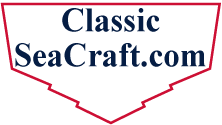
 |
|
#21
|
|||
|
|||
|
Thanks Don and Ken-I was totally surprised to hear that the 20 was too much. I need to run it. May be they were trimmed too low??? It show handle the load at least as good as the 250, right!? That manual plate sounds good.
__________________
Snookerd |
|
#22
|
|||
|
|||
|
I've looked at many many reports of repowers with the 300 Suzuki. 16x18.5 seems to be the ticket on almost every hull in the 22-26ft range. One boat used a 16x20 but I think that was an older 23 Contender.
I'm getting my White 300 installed 11/13. Cant wait! My buddy is repowering his 24 Proline with a black 300. Right now he has a 225 Yamaha efi, tops out at 40 mph. When I get his final numbers I will post them. Luckily my shop is a stones throw from Leading Edge Propeller if I need some cup.
__________________
Capt. Brian |
|
#23
|
|||
|
|||
|
Hey Capt., didn't I meet you quite a few years ago with Nick and Frank? Any chance you're coming to the rendezvous at MacRaes?
|
|
#24
|
|||
|
|||
|
Like Moose Im running the 16X20 on my 23 with the 250, and could easily go to the 21 pitch but happy with the performance as is. but my boat is a center console.
|
|
#25
|
|||
|
|||
|
Danny, I think I'd focus on getting engine height correct before you start changing props. You might pick up some rpm by raising motor and reducing LU drag.
Engine friction losses may also decrease a bit once you complete break-in, giving you a bit more HP at the prop. Although the E-TECs don't require a break-in and don't seem to experience any performance change once they get past the initial extra oil period (2-5 hrs >2500 rpm), some 4-stroke automotive engines typically run a little better after they "loosen up" and the rings get seated. Didn't notice any changes after break-in on my BMW, but those engines are bored & honed with head plates at the factory to insure perfectly round bores on new engines after assembly. That's an old hot rodder trick not done on most high volume production engines, where the bores distort slightly during assembly due to head bolt loads, creating high/tight spots that have to be worn down during break-in. Don't know if Suzuki machines their outboards with head plates, but that could determine if you gain any hp after break-in.
__________________
'72 SeaFari/150E-Tec/Hermco Bracket, owned since 1975. http://i188.photobucket.com/albums/z...Part2019-1.jpg |
|
#26
|
|||
|
|||
|
After giving this some thought and reflecting on Dan's (Headhunter) post I think there must be a glaring issue somewhere. There is just no logical reason a bare bones version of my heavy sled with 50 more horsepower doesn't turn at least 5800 or more WOT. It doesn't pass the smell test nor make any mathematical sense as well. If it was me I would be looking to see if the throttle body linkage is opening up all the way when the fly by wire hammer is put to the wood. I'm not sure that can be accomplished with the engine not running but I would put the key to the on position and check. If not I would get a buddy and pull the cowl and run it checking the same. Something is wrong and it isn't break in restrictions or oval cylinders. Maybe the ECM has a throttle limiter for a break in duration but I haven't heard on anything like that but maybe on the new "AP" models it exists. In any case your installer should be on top of this and answering these questions instead of dropping prop size that will mathematically drop your WOT speed below 40 kts.
Danny, If you want to talk to the best available Suzuki expert on the planet give Robert at Precision Marine a call. 727-518-2151 He would be more than happy to give you assistance over the phone.
__________________
[b]The Moose is Loose ! |
|
#27
|
|||
|
|||
|
Ken – I took the boat out today for additional break in time. I have about 2 1/2 hours. The most RPMs I've gotten to is 4000 at 25 knots. That is pretty close to what the pro line in their boat test section shows at 4000 RPM with the same prop 18.5 P. I think the motor could come up one hole. I will know tomorrow.
__________________
Snookerd |
|
#28
|
|||
|
|||
|
On to more serious issues.......you now have to change your picture.

|
|
#29
|
|||
|
|||
|
Yessir! Thank you.
__________________
Snookerd |
|
#30
|
|||
|
|||
|
Finally got past the break in restriction to be able to go WOT. Max is 5650 rpm @ 38.5 knots. Definitely dragging arse! Tell me about those manual plates.
__________________
Snookerd |
 |
|
|